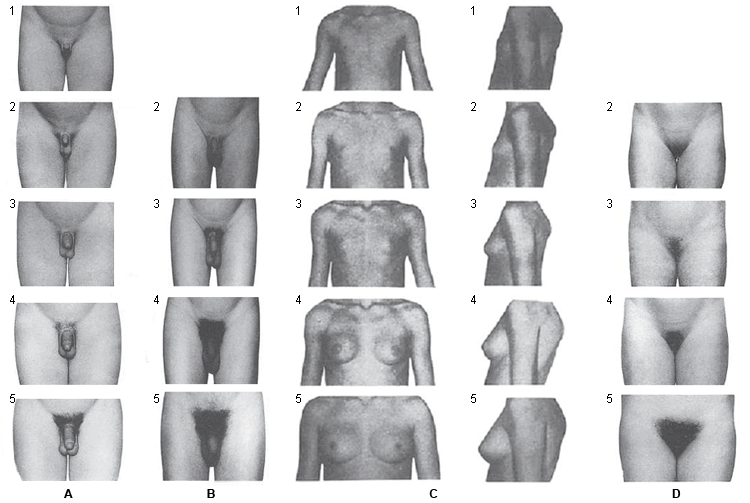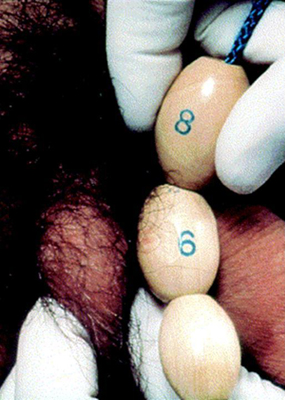Investigations
1st investigations to order
Tanner staging
Test
Pubertal development and progress are best assessed by Tanner staging.[38][39]
[Figure caption and citation for the preceding image starts]: Tanner staging: A, genital rating standards in boys; B, pubic hair rating standards in boys; C, breast rating standards in girls; D, pubic hair rating standards in girlsAdapted from Marshall WA, Tanner JM. Arch Dis Child. 1970;45:13-23; Marshall WA, Tanner JM. Arch Dis Child. 1969;44:291-303 [Citation ends].
Result
girls: absence of stage 2 breast development; boys: absence of stage 2 genital development
measurement of testicular size
Test
Testicular size is documented as a measurement of the longest axis or by the testicular volume using the Prader orchidometer.
Volume of 4 mL or a longitudinal length of 2.5 cm defines the onset of puberty.[39]
Most reliable indicator of puberty onset in boys.[1]
[Figure caption and citation for the preceding image starts]: Prader orchidometerCreated by BMJ Knowledge Centre [Citation ends].
[Figure caption and citation for the preceding image starts]: Method of comparing testicular size using the Prader orchidometerFrom the collection of Dr A. Mehta [Citation ends].
Result
boys: testes <4 mL
non-dominant wrist x-ray
Test
A non-dominant (typically, left) wrist radiograph helps to estimate bone age. The bone age indicates if constitutional delay is present or absent, and helps to predict the estimated adult height range and its relation to the mid-parental height.[1] The appearance of representative epiphyseal centres on the x-ray is compared with age- and sex-appropriate published standards. The most commonly used method is that of Greulich and Pyle.[42]
Result
delayed bone age suggests constitutional delay
basal follicle-stimulating hormone (FSH) and luteinising hormone (LH)
Test
Laboratory measurement of serum FSH and LH concentrations will help to differentiate patients with hypogonadotrophic hypogonadism (low or normal levels) and hypergonadotrophic hypogonadism (elevated levels).[1] The measurements should be performed on an early-morning blood sample using an ultrasensitive paediatric assay.
As the hypothalamo-pituitary-gonadal axis is quiescent up to about 10 to 12 years of age, levels of these hormones in children <12 years of age must be interpreted with caution. It may be difficult to distinguish constitutional delay from organic gonadotrophin deficiency, as the basal gonadotrophin concentrations may be low or normal in both groups.
Hypogonadotrophic hypogonadism results from a lack of serum gonadotrophin production or action, usually due to a hypothalamo-pituitary abnormality. Hypergonadotrophic hypogonadism results from gonadal insufficiency, and manifests with elevated serum gonadotrophin concentrations in the absence of pubertal signs at the appropriate age for puberty. Examples include Turner's syndrome and Klinefelter's syndrome.
Result
low or normal in hypogonadotrophic hypogonadism; elevated in hypergonadotrophic hypogonadism
Investigations to consider
luteinising hormone-releasing hormone stimulation test (LHRH)
Test
Gonadotrophin-releasing hormone (GnRH) testing can be considered in all patients with low basal gonadotrophins; however, sensitivity and specificity is limited.[43] Patients with elevated basal gonadotrophin concentrations, such as those with Turner's and Klinefelter's syndromes, do not need GnRH testing.[44]
LHRH is used to stimulate gonadotrophins. Serum LH and FSH are measured.
The test is not always useful in differentiating between constitutional delay and organic gonadotrophin deficiency, as stimulated serum FSH and LH concentrations following LHRH may be low in both groups, or may be normal and thus falsely reassuring in an individual with hypothalamic GnRH deficiency but preserved pituitary function.[45] Thus, it does not clarify whether an individual will progress in puberty spontaneously or has a permanent defect.
Result
low FSH and LH levels post-stimulation in hypogonadotrophic hypogonadism
inhibin B
Test
Promising biochemical investigation for the diagnosis of delayed puberty. In males, it is produced exclusively by the Sertoli cells of the testes, and in females by the ovarian granulosa cells and the placenta.
In males, the trio of small testes volume (cut-off: 1.1 mL), low maximal stimulated LH on gonadotrophin-releasing hormone (GnRH) stimulation testing (cut-off: 4.3 IU/L) and low basal inhibin B concentration (cut-off: 61 pg/mL) have been proposed as the most effective discriminator between permanent hypogonadotrophic hypogonadism and constitutional or self‐limited delayed puberty.[18]
The utility of inhibin B has been less clearly demonstrated in girls.
Result
males: low inhibin B suggests permanent hypogonadotrophic hypogonadism
anti-Mullerian hormone (AMH)
Test
Produced in males from the testicular Sertoli cells from the time of testicular differentiation to puberty. In females, it is secreted by the ovarian granulosa cells from birth until menopause, although the concentrations in girls are significantly lower.
Patients with dysgenetic gonads have low serum AMH. Undetectable AMH and inhibin B are characteristic of congenital anorchia, but may also be seen in males and females with severe hypogonadotrophic hypogonadism. AMH and inhibin B may be used, therefore, during assessment of testicular or ovarian function and capacity (as a marker of potential for fertility), and as a diagnostic tool in conjunction with serum gonadotrophins for both hypo- and hypergonadotrophic hypogonadism.[47]
Result
males and females: low or undetectable AMH indicates hypo- or hypergonadotrophic hypogonadism
human chorionic gonadotrophin (hCG)stimulation test
Test
Three-day and/or 3-week stimulation used.
hCG is used to stimulate testicular production of testosterone, and has been suggested to be useful in some patients when combined with the luteinising hormone-releasing hormone test to help distinguish constitutional delay from hypogonadotrophic hypogonadism.[45]
A rise in serum testosterone concentration is observed in constitutional delay; a decreased testosterone response is seen with hypogonadotrophic hypogonadism.
Result
poor testosterone response in hypogonadotrophic hypogonadism
MRI brain
Test
Should be considered if basal gonadotrophins are low in the absence of a family history of delayed puberty. MRI brain is mandatory if other pituitary hormone levels are found to be deficient.
Neuroimaging of the brain helps to identify structural hypothalamo-pituitary abnormalities, midline brain defects, olfactory hypoplasia, and pituitary tumours.[1][50]
Result
normal or pituitary tumour, forebrain defects, olfactory hypoplasia
karyotype
Test
A karyotype examination should be considered in all short girls, tall boys with body disproportion, or any patient with primary (hypergonadotrophic) hypogonadism. In boys, it may reveal Klinefelter's syndrome (47XXY); in girls, it may reveal Turner's syndrome (45X). Turner's syndrome (45X) should be considered in all short girls, with or without other phenotypic features suggestive of Turner's syndrome.[41] Depending on the mosaicism, 45X/46XY mixed gonadal dysgenesis may present with ambiguous genitalia at birth or with delayed puberty in adolescence.[40]
Chromosomal microarray may be indicated in patients with hypergonadotrophic hypogonadism with additional congenital abnormalities or syndromic features.[48]
Result
abnormal in Turner's syndrome, Klinefelter's syndrome, and other disorders of sexual differentiation
ultrasound pelvis and abdomen
Test
Pelvic ultrasound examination should be considered in girls with Turner's syndrome or other forms of gonadal dysgenesis, as well as in girls with hypogonadotrophic hypogonadism.
In those with hypogonadotrophic hypogonadism, it is useful for the assessment of uterine and ovarian maturity (volume, shape, and endometrial thickness) for diagnosis and before starting treatment to allow monitoring of response to therapy.
Abdominal ultrasound may reveal renal abnormalities such as agenesis or a horseshoe kidney.
Result
dysgenetic gonads in Turner's syndrome and other forms of gonadal dysgenesis
echocardiogram
Test
Defects are clearly visualised.
Result
coarctation of the aorta or bicuspid aortic valve in Turner's syndrome
serum ovarian autoantibodies
Test
Measurement of ovarian antibodies may help to identify an autoimmune process. Consider if baseline serum gonadotrophins are elevated. Autoimmune disease of other endocrine organs may also be present (e.g., autoimmune adrenalitis, autoimmune thyroiditis).
Result
positive in autoimmune endocrinopathy
assessment of olfaction
Test
Kallmann's syndrome is an association of organic hypogonadotrophic hypogonadism and hypoplastic olfactory nerves, resulting in anosmia.
A formal ear, nose, and throat examination may be necessary.
Result
anosmia
thyroid function tests
Test
Hypothyroidism can cause hypogonadotrophic hypogonadism.
Result
elevated thyroid-stimulating hormone (TSH) and low free thyroxine (T4) in primary hypothyroidism; low or normal TSH and low free T4 in central hypothyroidism
serum prolactin
Test
Can present as delayed puberty.
Result
elevated in hyperprolactinaemia
other pituitary hormone investigations
Test
Consider if diagnosis of hypogonadotrophic hypogonadism is suspected. Congenital gonadotrophin deficiency may be isolated or be associated with combined pituitary hormone deficiencies, with or without midline brain disorders, in septo-optic dysplasia and holoprosencephaly.[22][50] It may also be associated with adrenal hypoplasia (mutations in NROB1).[23]
Result
may reveal panhypopituitarism
Emerging tests
overnight gonadotrophin profile
Test
May demonstrate pulsatility, but its role in the long-term prognosis of delay is unclear. It is primarily undertaken in a research setting.
Result
low number of LH pulses in hypogonadotrophic hypogonadism
genetic sequencing
Test
For individuals with suspected congenital hypogonadotrophic hypogonadism or Kallmann's syndrome, next-generation sequencing panel testing is now available in the UK and some other world regions.[49]
Result
presence of certain gene variants (e.g., ANOS1, CHD7, FGF8) may confirm genetic diagnosis
measurement of LH following stimulation with kisspeptin
Test
Proposed as a useful test to identify individuals with gonadotrophin-releasing hormone (GnRH) deficiency and thus permanent hypogonadotrophic hypogonadism.
Kisspeptin stimulates GnRH pulsatility, thus promoting LH - and to a lesser extent FSH - secretion.
One clinical study found that maximal LH rise after kisspeptin administration was more accurate for the diagnosis of men with GnRH deficiency than GnRH stimulation testing.[51] In one parallel study in adolescents with pubertal delay (3 females and 13 males), peak LH post kisspeptin stimulation was demonstrated to be superior to GnRH stimulation testing for predicting capacity to progress through puberty.[52]
While further research is required to delineate the parameters of using kisspeptin in clinical paediatric practice, this is a promising area for the biochemical diagnosis of GnRH deficiency in adolescence.
Result
elevated LH following kisspeptin stimulation may suggest permanent hypogonadotrophic hypogonadism
Use of this content is subject to our disclaimer